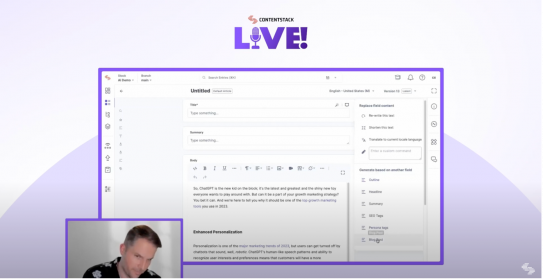
ChatGPT: What will be left after the hype?
Are you worried you might lose your digital sales or marketing job because of ChatGPT? Well first things first. Let’s deep dive into the type of AI that drives ChatGPT, examine the opportunities and risks that it brings and then look at what we can expect in the future.
The AI behind ChatGPT
ChatGPT is currently recognized as one of the most advanced forms of conversational AI, a form of artificial intelligence that imitates human conversation. Conversational AI is based on deep learning which represents the simulation of a neural network, a computer-based model based on how the human brain works.
A neural network learns context by tracking relationships, recognizing patterns, and developing new patterns in sequential data such as parts of images or words in a sentence. Iterative steps are used to convert an input layer into an output layer, providing new information or meaning.
Let’s take image recognition as an example. A digital image consists of millions of pixels. The combination of these pixels, according to a certain structure, are then turned into an object which can be recognized as an image. Neural networks recognize images by processing pixel values to extract patterns and features, enabling them to identify and understand visual content. (See visual below)

Image taken from stackoverflow.com
Getting back to ChatGPT, which is a language-based AI, where meaning can be derived from letters to words, to sentences and dialogue. This AI knows how to react to questions and provide meaningful and relevant answers or information. (See visual below)

Screenshot from Contenstack Demo-Session showing the ChatGPT context menu on the right side.
However, it is important to bear in mind that AI scientists describe this type of capability as weak AI as it is based on the quality and amount of input data provided, otherwise known as “training data”.
As a result, ChatGPT is not able to develop additional meaning or information and it cannot understand complexity. Nevertheless it is still the highest form of AI we currently have available.
The potential of ChatGPT
As the most advanced chatbot available today, ChatGPT is able to help digital salespeople or marketeers in their day-to-day work by producing:
Generating Marketing Content with AI
ChatGPT can quickly churn out marketing texts with a focus on products, services and features. It is however limited to standard information.
Use cases
It is also an excellent tool for producing use cases that include:
- Product descriptions- based on product specifications
- SEO-optimized text, according to keyword density (a pattern)
- Automated translations- into several languages
- Adjust text- so that the length of the text is optimized for different online and offline communications channels
ChatGPT can even write programming code or get involved in simple dialogues. For example, it can provide basic product information on T-shirts or make recommendations for additional products based on known features or attributes. But it can’t handle anything too complex such as complicated shipping services.
The benefits of ChatGPT for eCommerce
There are at least two main reasons why an eCommerce merchant may consider looking at ChatGPT closely.
Chatbot Technology
The first one is because of the chat dialogue technology that helps users to get to the right selection of products. Because of ChatGPT’s ability to quickly understand simple structured questions, it can easily lead a user to the products they are looking for. This is particularly beneficial when the professional subscription version is used as you can associate your own product data with the data resource of ChatGPT.
AI-Powered Marketing Automation
The second reason is because of its marketing automation capabilities. ChatGPT can write entire trigger mails (emails that help move people through the sales funnel) including status updates or recommendations based on buying behavior or marketing campaigns.
It can also be used for A/B testing by for example writing two different versions of the same email. As a result, Bloomreach or Contenstack and other Digital Experience software providers, have started integrating ChatGPT into their solutions and plan to use it to write their newsletters or articles for them.
In an era where faster time to market and the ability to adapt to constant change are key to the success of an eCommerce business, ChatGPT can be seen as an ally as it can quickly generate content for each stage of the customer journey. By taking care of content creation, ChatGPT allows marketeers and commerce managers to focus on more value-added activities such as defining and analyzing KPIs and adapting their marketing campaigns accordingly.
The Limitations of ChatGPT
Chat GPT is only as good as the data it has access to. And it has only been fed data that dates before 2021. This means that some of the data it is currently working with is out of date.
Google Bard, Google’s alternative to ChatGPT, claims it can work with an unlimited amount of data because it makes use of live data from the Internet. However, Bard has just been released for public testing. When it initially became the talk of the social tech communities it was said that Bard sometimes provides wrong answers to questions. This had a temporarily negative impact on Google’s stock price. Furthermore, it needs a lot of power, that is to say, a high CPU (central processing unit) capability in order to function. Despite these drawbacks, we can however be sure that Google will be able to challenge ChatGPT.
As mentioned above, ChatGPT is most reliable when it comes to non-complex questions. Therefore, it’s best to stick to one topic per question otherwise it may get confused. It’s important to remember that the text it creates sometimes lacks depth or insight. And it is biased, because it receives its information from human sources that are biased, this could be extremely risky for a brand’s image. This is why I can’t stress enough the importance of using it for simple questions based on standards, not those requiring an ethical human touch.
What the future holds for ChatGPT
The fact that ChatGPT has woken up giants like Google and also Microsoft is a good thing as this will ensure the continuous evolution of conversational AI. And now that it is part of relevant software solutions, this means that, from a technology perspective, it will become easier to use with back-office environments.
For example you won’t have to switch to the ChatGPT application to generate results which you then copy to your CMS, PIM or E-Commerce back office for usage.
If you are working with products with complex variants or niche products that require a lot of explanation, I would advise you to talk to an expert who can evaluate the extent to which ChatGPT can really help you.
To go back to my initial question “Are you worried you might lose your digital sales or marketing job because of ChatGPT?” Well for the moment I strongly believe there is no need to panic. As explained above, AI can only work with information which already exists. To define something which doesn’t exist today is still the part when human intelligence comes into the game.
However, your job will certainly be a lot different. You will spend less time on creating, adapting, and enriching text and more time on working with the results and making strategic decisions. We should consider ChatGPT as a tool that helps us to do our job better. It can be compared with the task of calculating. You can do this manually or with a pocket calculator so that you can focus on the result of the calculation.
So, to sum up let’s call ChatGPT an ally not an enemy for the moment.
DID WE PIQUE YOUR INTEREST ?
Get in touche to discover how we can drive your digital sucess.
Contact Us

